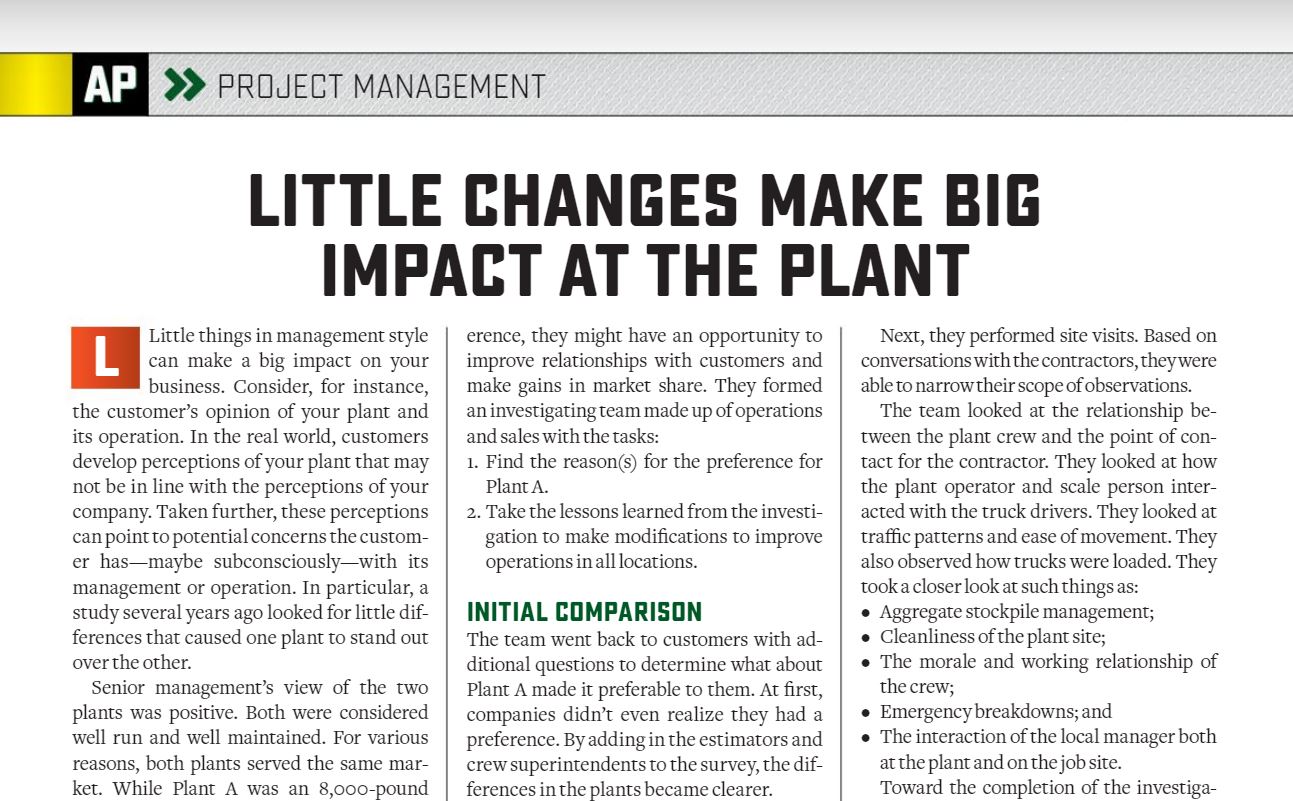Little Changes Make a Big Impact at the Plant
BY Ken Monlux

Little things in management style can make a big impact on your business.
Consider, for instance, the customer’s opinion of your plant and its operation. In the real world, customers develop perceptions of your plant that may not be in line with the perceptions of your company. Taken further, these perceptions can point to potential concerns the customer has—maybe subconsciously—with its management or operation. In particular, a study several years ago looked for little differences that caused one plant to stand out over the other.
Senior management’s view of the two plants was positive. Both were considered well run and well maintained. For various reasons, both plants served the same market. While Plant A was an 8,000-pound batch, Plant B was a 10,000-pound batch, but both had many similar characteristics that make the comparison valuable:
Located in an urban setting (within 15 miles of each other);
- Commercial plants serving independent paving contractors;
- Batch plants with two 100-ton silos;
- Managed by a plant/service manager;
- Same source of aggregate and liquid asphalt;
- Same mix designs;
- Same hours of operation; and
- Same outcome in quality control.
In general, both plants should have been, with the exception of production rate, the same. Surprisingly, a majority of customers came to prefer Plant A.
The preference wasn’t detected right away. The sales staff spotted it when they called on customers and the request for Plant A was brought into the conversation. In many cases, the customer may have even chosen Plant A when it meant a slightly higher cost.
The sales team discussed the anomaly while meeting with operations, and management decided to take a deeper look into any differences between the two sites. If they could solve the “why” customers had a preference, they might have an opportunity to improve relationships with customers and make gains in market share. They formed an investigating team made up of operations and sales with the tasks:
Find the reason(s) for the preference for Plant A.
Take the lessons learned from the investigation to make modifications to improve operations in all locations.
Initial Comparison
The team went back to customers with additional questions to determine what about Plant A made it preferable to them. At first, companies didn’t even realize they had a preference. By adding in the estimators and crew superintendents to the survey, the differences in the plants became clearer.
The outcome, with the customers, was a perceived discrepancy in the mix supplied to the job sites. In addition, the overall observation of Plant A performance was rated higher. The basis of these differences was anecdotal, and not based on quality control or placement performance testing or other quantitative analysis. It came down to personal preference, perceived performance or the look of the placed mix at the job site, the relationship with the plant crew, and the perceived plant performance including plant breakdowns and traffic flow.
With this information in hand, the team developed a plan to investigate the plant’s operations or plant performance to account for differences.
The operational side of the team reviewed both plants. At first glance, no one could quickly identify any differences in performance, but as they dug deeper, the team started to see small differences.
The first step was to compare the plants based on data collected over the prior year. They did a side-by-side comparison of production rate by month; quality control by mix, gradation, AC content, and compaction; uptime availability; and repair hours.
Next, they performed site visits. Based on conversations with the contractors, they were able to narrow their scope of observations.
The team looked at the relationship between the plant crew and the point of contact for the contractor. They looked at how the plant operator and scale person interacted with the truck drivers. They looked at traffic patterns and ease of movement. They also observed how trucks were loaded. They took a closer look at such things as:
- Aggregate stockpile management;
- Cleanliness of the plant site;
- The morale and working relationship of the crew;
- Emergency breakdowns; and
- The interaction of the local manager both at the plant and on the job site.
Toward the completion of the investigation, no major differences stood out. What did become apparent were many little operational differences, that, when linked together, made a noticeable difference.
Small Differences Add Up
The following discussion offers a small sample (in no particular order) of issues discovered. The purpose is to demonstrate the nature and magnitude of these differences.
Management styles varied from Plant A to Plant B. The Plant A manager was visible at both the plant and the job site. He made sure to contact all job sites being supplied on any given day. He spoke to job site supervisors and maintained a line of communication with the job. He was seen at the plant site ensuring the production was running smoothly. In the case of traffic flow problems, the manager stepped in to control the flow. Overall the manager was visible.
The Plant B manager prioritized job site visits to major projects only. He may or may not have contacted job site supervisor. At the plant, the manager was located at his office and would only walk the plant site in the case of an issue that came up demanding his attention. He maintained contact with customers through sales staff. Overall, the manager was not as visible as compared to plant A.
Plant performance varied. Plant A’s overall look was neat and clean with a clear traffic flow. The plant had been recently painted and did not have any major spills or stains.
Plant operator had a great ability to remember names of truck drivers, and other contractor’s contacts. He always greeted them by name. In addition, the operator remembered how the driver liked to have his truck loaded and made every effort to comply.
Plant mix in general was in specification and performed well in placement.
The number of breakdowns was in line with expectations of senior management. There were differences between plants in the time it took to perform the needed repair and to get back on-line. Plant A up-time availability was much higher than plant B. The differences were centered around the pre-planning of the manager, and the morale and teamwork of the crew.
Plant B’s overall look was less than neat. Waste material was allowed to collect throughout the site. The asphalt tanks had overflow stains, and the plant needed new paint.
The plant operator was very qualified and professional but did not go out of his way to interact with the truckers or other outside personnel.
The cold feed aggregate stockpile was in disarray, with confusing traffic between the incoming aggregate trucks and the outbound trucks.
Like Plant A, the number of breakdowns was also in line with expectations of senior management. Unlike Plant A, the breakdown repairs at this site took longer for the plant to come back on-line.
Apply Lessons
Prior to the investigation, it surprised the team that customers could form different opinions about two similar plants. Based on the outcome of the investigation, management discovered that a number of small differences in the plant crew and management were not only noticed by customers, but came to influence customer plant preferences over time.
The lesson in all this is that the little thing in the plant operation can lead to changes in perception of your business as a whole. By being aware of how employees look, act and perform to those on the outside of the company, you will not only become a better supplier of material, your company could become the preferred supplier.

Ken Monlux
This article is a summary of a PowerPoint presentation titled “Little Changes,” which is intended for winter management meetings. Ken Monlux is an asphalt industry veteran with 30 years experience in all areas of operation management. For more information, contact him at (209) 495-1017 or kenmonlux@yahoo.com.
